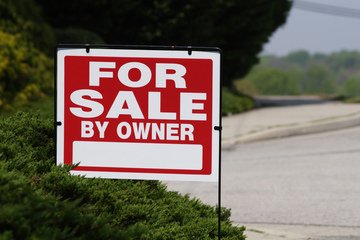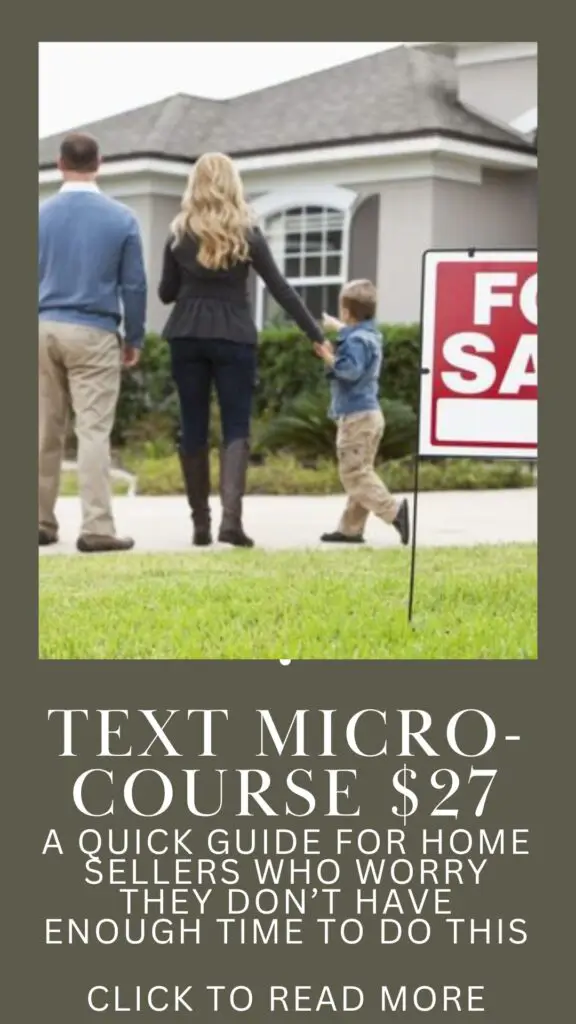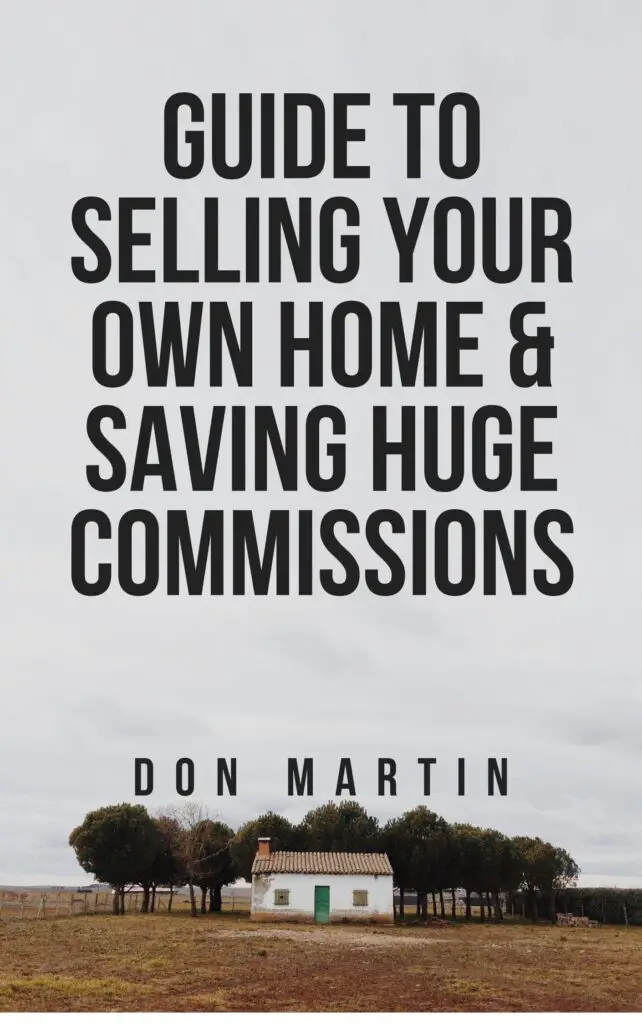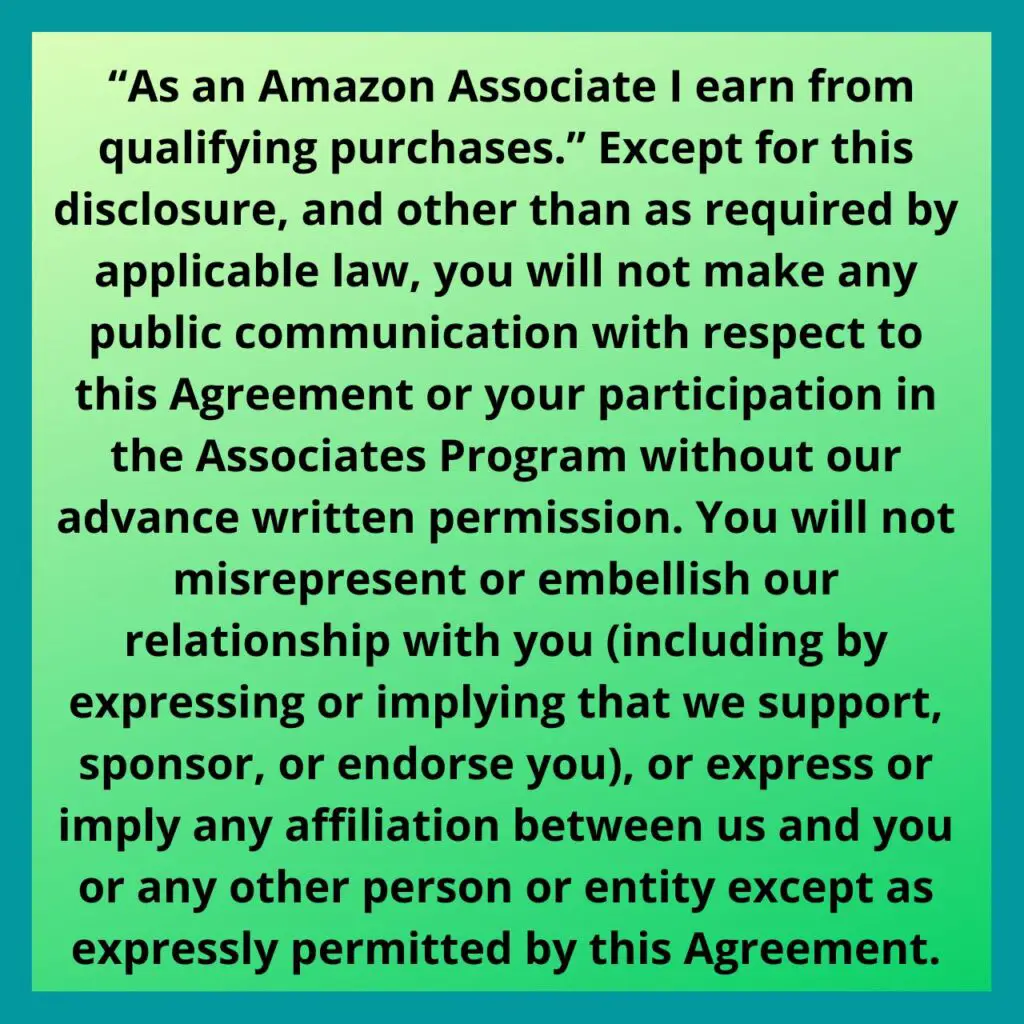Step by Step Resource for Selling Your Own House
1 First Steps
Deciding to sell
Well, it happened one morning. You woke up and your house was not right any longer. You need a bigger house. You need a smaller house. You fell in love with another house. But for one reason or another, you aren’t happy with your current one.
So if another house would make you happier, then go for it. If you are like most people, you don’t need two houses. One has to go. You could rent it out. That could cover the mortgage, if there is one, or bring you some extra income, or both.
But renting does bring a new set of challenges the discussion of which is beyond the scope of this writing. These challenges may even negate the value of the advantages. So that leaves us with the thought of selling it.
Someone has to do the work of selling the house- taking the phone calls, letting in the prospects, even eventually doing some paperwork. In order to save the commission, are you up to selling it yourself?
Even property developers seem to agree.
To List or Not To List?
There is a good side to listing. You don’t have to do the work. You don’t have to deal with the occasional silliness out there in the public.
But there is a down-side too. It costs a lot of money. You have to surrender some of your control over the situation. And it costs a lot of money.
Put it in the MLS
But even if you decide to sell your own house, it would be a good idea to have the exposure of having your house in the Multiple Listing Service System. Why? There are ways now that you can have your house in the MLS, and yet still be a for-sale-by-owner, FSBO. That way you get the best of both worlds. You get the power of the MLS system, and you get to sell your own house. If you pay anything, any commission, you will only pay the buyer’s agent, and that will be half of what it would be in a regular traditional listing scenario.
So what you need to do is to look around in your city for a broker who will do a flat fee MLS entry-only listing for you. The agent won’t be giving you advice, or reviewing your contracts, but he won’t be charging you. What you are paying for is for him or her to have a license and the membership required to put your house in the MLS system. The amount you are paying is a fraction of the amount you would normally pay another Realtor, but you are only getting a fraction of the specialized service. That is to say, he is only getting your listing to be active, not answering phones showing your house, holding open houses, or being on call around the clock. That is perfect for some sellers.
One caveat, selling you own house is still not easy. It is time-consuming. It is thankless for the most part. But it will surely save you money in the end, when the process is complete.
2 Property Condition Disclosures and Handouts
Property condition disclosure.
The property condition disclosure is a form that’s about five or six pages long containing questions about different items on your property. It asks about items such as the electrical, or plumbing, or heating and air systems. It asks if there is a problem, or if there has ever been a problem with any of them. You need to go through all of these questions and answer them all just as truthfully as you can.
If you have a question or a doubt about something, I personally feel that it’s better to over-disclose than to under-disclose. I have never seen a transaction fall apart because of over-disclosure. I have, on the other hand, seen hurt feelings once or twice because of perceived under-disclosure. So if if there is anything that you would want to know if you were the buyer of the house, then you need to put it on there. Even if you don’t know whether something is important or not, go ahead and disclose it on that sheet of paper
Make some copies of this completed disclosure sign it at the bottom. Make some copies and keep them handy. I would not leave a stack of copies on the dining room table, because everybody feels compelled to take one. You really don’t need to give anybody one of those unless they are about to make you an offer on the house.
Send me a copy of the disclosure in PDF form and I will see that it is placed on your listings media page
Exemption if not live there.
If you have not resided at the property in the last three years, then you get to sign what is called an exemption. A Property Disclosure exemption states that you haven’t lived there. There are a couple of the choices that explain how you acquired the property, but this is just a quick couple or three page form that lets you sign that you were you’re not going to complete the long form. This is what you would give to somebody to to fulfill the law prior to their making you an offer if you did not have a standard Property Disclosure to give them.
LBP disclosure.
Federal law mandates that Sellers of housing constructed prior to 1978 must complete certain Lead-Based Paint Disclosure requirements. These forms should be completed before the Buyer makes an offer, and certainly before the Seller accepts a purchase offer. Otherwise, the Buyer may not be obligated under any contract to purchase such housing.
Have one of these stapled to property disclosure where ever you have them available.
The Seller needs to say that he knows or he doesn’t know of any lead-based paint in or on the house. The Buyer needs to say he cares or he doesn’t care.
Buyer and seller sign. Buyer’s agent and listing agent all sign.
Fact/rate sheet about the house
Look around in your area for lenders, mortgage companies or mortgage brokers. They sometimes have or have access to software that takes a home listing and prints out a couple of loan product details based on different down-payment amounts, and showing hypothetical monthly payment amounts.
This is a wonderful thing to have the lender use your house address and your asking price to work up such a sheet. People who come to see your home, whether it’s an open house or just an appointment, like to have a souvenir to take home with them. One of these would be an excellent item to accompany a fact sheet on your home. After someone has looked at a few houses, they start to run together in their memories, so this would be to your advantage.
My guy in this geographic area is Hal Tennant, but you will find someone equally capable in your area who is willing to do the amount of work involved to make this item. A side benefit to the lender is the exposure that he/she gets from the fact that they will have their picture and contact info on the form as well.
3 Clean and Shine

Very Clean
I suggest that first of all, you hire an actual maid service for the first step. Spend the money, and get their thorough, first time cleaning.
You can go to Craigslist and get two or three estimates. They will probably all be fairly competitive, price-wise, so pick the one that you like best, and just have them do that
There is a phenomenon I call incrementalism. It means that when it comes to the condition of your house you get used to things being out of place a little bit at a time, and eventually, a lot can end up out of place and you not even notice. So a made service would be ground zero for the clutter in your house
Once your house is in great shape, then your job is to maintain it to be that way. You may have to have the maid service come back periodically, or you may be able to do it yourself once it’s thoroughly clean. But that is imperative to sell your house. When somebody looks at your house, if they think you have ignore maintenance on small things, they will be tempted to think that you ignore maintaining the larger things.
Put away
These days there is a fairly new concept called “pods.” Pods are like storage areas that you can rent, except they’re put on your own driveway. You don’t have to drive to the storage facility. The company will even pick them up after you fill them, and move them to your new house.
I like and recommend these for many of my customers. They may not look great in the driveway for a period of time, but what they allow you to do is to gather up all the stuff you don’t use on a daily basis and put them in the pod. That lets you to have more room in your house and a lot less clutter.
Landscape
While you are at it, call two or three landscape companies, and have them look at your yard. Have them tell you their vision for your yard and give you an estimate of the cost for their vision.
This may be exactly the ticket to give your house more curb appeal, and it possibly might not cost that much money.
Please “LIKE” our FaceBook Page through clicking this link. We can provide even MORE there than we can here on this website! In addition to our own content, we keep track of several other similar blogs for you and share posts there! MAKE THE MOST OF YOUR VALUABLE TIME!
Have fresh eyes look
Finally, have a trusted friend just take a look at your overall house and yard. Ask them to be brutally honest, and tell you what they think you still need to do to make your house attractive enough that it would be sold.
Accept what they say, and use it or don’t use it, but thank them. Don’t argue with them. Just used their advice as you wish. Fresh eyes always see a problem more clearly then the eyes that have looked at the problem all the time.
When it’s the way you want it, freeze it in time. Take some photos. Make them good. There is a science to that, so do it right. Don’t just take a picture of a corner of the bed or dresser. Get your ROOM in the shot, unless you are selling the furniture.

Tap or click for more about camera.
This is the type camera I use. I’m not trying to be a snob here- I’ve seen some pretty good shots with phones, too! This one just works for me. Pay attention to what you are doing, and be sure the results are what you want.
4 Showings and Open Houses
Fact sheets
This overview will mention three types of fact sheets, OUTSIDE, INSIDE, and Mortgage rate sheets. It is your decision, obviously whether you will use one or more in the sale of your house.
OUTSIDE
This sheet lives in a small box or tube on or near the FOR SALE sign. Variations on this concept are the QR code on the sign and the website that can be accessed by smart phone. All simply deliver facts about your house to a stranger. The simplest fact sheet would be a copy of the MLS listing. There are also software programs available with which you could design a more attractive fact sheet.
When you first decide to sell your house and offer a fact sheet, I suggest you see approximately how many homes are in your neighborhood, and supply black and white copies up to about a third the number of neighbors before you start putting out a color sheet or more expensive brochure.
Another concept I sometimes employ is to leave off some very important fact, such as the price. Any reason to cause the looker to have to call you is what we are looking for here. Nothing ever happens until there is a conversation.
INSIDE
The inside fact sheet could actually be the same as the outside, or even nicer. It simply depends on how much you want to spend. People seem to enjoy having something to take along home with them. You should have your property condition disclosure forms handy but not sitting out, or they will take one of those too.
MORTGAGE RATE SHEET
This sheet we have discussed previously that is prepared by a Mortgage company specifically dealing with your house. It will show down payments and monthly payments based on a couple of different factors.
Pointer signs
Pointer signs are sometimes used during an open house if your house does not sit right on the main road. Pointer signs usually succeed if you have two turns or fewer.
Some people use pointer signs for the entire time the house is for sale. It is your choice. Pointer signs can be invasive. If you put them in the right away, sometimes and neighborhoods have rules against that. They will be collected and tossed.
So it’s best to put pointer signs back from the street just a little bit. But of course, that’s somebody’s yard. Always try to check with the owner of that yard and be sure it’s okay for you to put your pointer sign there. Some areas only allowed pointer signs on the weekends during open houses.
Captions
In the Middle Tennessee MLS we have spaces for 20 photographs including the primary picture. Under each photo there is room for a caption. Captions look best as one or two conversationally styled sentences. Bullet lists don’t look good in that format. We have 250 spaces for letters or spaces. That amounts to a couple of complete sentences. after 250 letters the system drops the rest.
If you do captions don’t mention the obvious mention something that is not obvious and not dealt with in the rest of the listing. You should also check the type listing that you have. Some very basic MLS entry-only listings do not allow captions under the photos.
Tent signs
Tent signs are nothing more than 3 x 5 index cards folded in half, so that they stand up like a pup tent. Since your house will be selling itself, you may need to let it explain some items that may not be readily apparent. For instance, you put all new cat 5 cable behind this wall, but it doesn’t show up in the picture.
Elsewhere, I explained that you should not be giving the tour but of course there are things that need to be pointed out, and with tent signs this can be accomplished with ease. I have had Realtors tell me that they hate my tent signs because they make control of the prospects. People are looking for the next easter egg, and concentrating on the house, rather than the agent, and that makes some of them feel unimportant.
You might say that the tent signs may end up reading like the picture captions. The important thing is neither you nor the agent will be will sell your house. Your house will sell itself when the magic happens as the prospect looks at it. We need to simply let that happen.
Dialogs
The first dialogue to remember is for when the phone rings, and somebody is asking you to see your house. At that time, you need to ask whether or not that person is working with a Realtor.

If that person says “no,” then you say “great let’s make a time for you to see the inside of my house.” If that person says “yes I am working with a Realtor,” then you say “if it’s all the same with you, I don’t want to step on any toes, so would you please coordinate this with your REALTOR.”
The best surprise is no surprise, and now you know if somebody is going to be expecting to be paid a commission, because that will affect the cost basis of your sale transaction. If someone will be expecting commission, they need to earn the commission by doing the legwork, setting up the appointments, and conducting the tour for the potential buyer.
If the person says that he has a Realtor but just wants to look on his own before he involves his Realtor you say that could potentially cause a problem, so just please have their Realtor present.
The second dialogue you should know is used when someone is touring your house. You let them in the door, and tell them “you folks know what you’re looking for, so make yourselves at home. If you have any questions, I’ll be right here, so just holler up.” Let them look around the house, and you sit on the sofa. Don’t feel compelled to leave, and please don’t feel compelled to do the tour.
Getaways
Getaways, or leaving the premises while your home is being shown, really don’t need to occur. Whether the prospect is with a Realtor or by themselves, just let them look on their own. Sometimes people even feel pressured when the seller is there giving the tour. Sometimes you may not be good at giving the tour, and you explain things we are very evident. You can, in some cases, insult the prospect’s intelligence. So sit on the couch while they look.
If the prospect is by themselves and not with an agent, and you feel a little worried to be alone in the house with them, have your car parked in the driveway, and excuse yourself to work on your laptop or return some phone calls. That way, you can see the front door so nobody steals your TV, and you are in sight of the neighbors if that makes you feel better.
Some agents recommend you drive around the block or go somewhere while they sell your house. Just politely, yet firmly tell them where you will be, on the sofa, or in your car in front of the house.
5 Commissions, bonuses, and buyer incentives
Price boldly, reward modestly
I have found that many people, after they have owned their house for a while, don’t always realize the value of their house has grown significantly. They keep thinking of their house in terms of what they paid for it when they bought it originally, but the times change and the housing markets change, and it’s good to be fairly sure of the value of your house before you put it on the market.
People who live in your neighborhood can usually tell you what houses are selling for in that neighborhood, so you don’t really have to pay for an appraisal, or necessarily have a real estate agent run the comparable sales for you. You already have a pretty good idea of what your house is worth.
Moreover, you have a pretty good idea of what you owe on the house and what you have spent on the house. Therefore, you probably have a pretty good idea of what you would like to receive for your house.
This is the point where sellers get a little shy and think that maybe nobody would pay that kind of money for their house. The trick is to get past that feeling. I propose that my customers go ahead and price their house boldly. The market value of your house will tend to seek its own level, but if you start out too low but you may lose money quickly that you may have otherwise have received. So I suggest you select a strong figure for your house, and evaluate the showings over the first two or three weeks.
If you put your house in the Multiple Listing Service, you have to offer a specific amount to a participating broker if one brings a buyer to the transaction. That is a large piece of your price consideration. This amount varies in different parts of the country. We can’t just pick an amount, and call it standard, because nothing is standard.
But if we say that different areas of the country pay slightly different commissions, then we are not trying to fix their price at any particular level. Each commission is determined by each real estate company. In a traditional listing, the commission is paid by the seller to the listing company. The listing company often offers a portion of that to a selling company. sometimes it’s 50% of the total commission. sometimes it’s less. This also varies within a state and within the country.
If you are selling your house FSBO, then what you are offering is the half or portion that is offered to a selling broker. So let’s do some quick math. If the Commission in your area were 5%, and if it were split 50% to listing and 50% to the selling broker, then you would just offer half of 5% or 2.5% to a selling broker to bring you a buyer.
With my customers, about half of them sell to someone who is working with a Realtor and half sell to someone who is not. What that means is, if you are selling a $100,000 house as a FSBO in the MLS , you may end up owing an agent $2,500 in commission.
You may also owe nothing if the buyer used no agent.
The fact is that in many areas of the country a more standard commission total commission is 6% and in some areas of the country the total commission is 7% or more. The thing to remember is that it varies. It’s not written in stone.

Many of my customers start off offering 1 to 2 percent. Some of them offer a specific dollar figure. This gives them a pretty good handle on their cost of sale from the start. Always remember that an agent could bring you an offer that is good enough that he may get you to negotiate your commission figure to a higher rate. But that is your call, not theirs.
Right place right time
There was a time earlier in real estate when someone who wanted to buy a house would talk to a real estate agent, and explain what they were looking for in that new house. The agent would then go to his books or even his computer, and search through houses that were on the market to find a house that was suitable for this buyer. Sometimes the agent would give the buyer reports and lists of houses that qualified so that the buyer could drive by or tour those houses. That system was Realtor driven. The agent picked out the houses to see.
Now in real estate, when someone decides to buy a new house, they make themselves comfortable on their sofa, get online, and surf web sites looking for a house they like that suits their needs. When they find a house they like, if they are working with a Realtor, they call that Realtor and ask him or her to get them in a particular house. This system now is customer-driven.
Whereas in the old system, the agent worked to find the correct house for the buyer, the new system, commissions are often earned by the agent who is in the right place at the right time.
Half and half
We talked already how whatever standard traditional commissions are offered, they’re often split half and half between the listing and the selling companies. There are other splits involved. Individual agents must split commissions with their companies. Commissions are always paid to the broker (company,) and then the broker pays the agent. there are many different splits with different companies, some 50/50, some 75/25, some 90/10, depending on the company, the experience and production of the agent, and the amount of support the company provides to the agent. There are some companies good pay 100% of the commission to the agent, and the agent in turn pays monthly fees to the company.
So the amount of money you’re offering as a condition is not just handed to the agent who is doing the work. just remember a lot of people share that amount.
Commissions vary
I already mentioned that many of my customers start their listing offering 1 to 2%. It varies and it is negotiable. Also remember that each agent is usually working for a broker that determines an acceptable level of commission for that company. I work with one or two builders and house flippers who just call me and give me the address of one of their houses that is ready to be on the market. Some of my sellers I know to start out at 5% to the buyer’s broker. This is a high figure, but some of my builder customers have decided they are not in business to inventory houses, and they like to move them quickly. So you determine commission level partly by how quickly you need or want to sell your house.
Bonus
Sometimes it’s a nice incentive for buyers’ agents to offer them a bonus for an acceptable offer on the house. That is good proactive marketing. Have the listing agent mention it in the listing, preferably in all caps, and for a specific period of time so you can measure the results. In other words, try “$1,000 bonus for an acceptable offer by May 10th.” Make it a two week window of opportunity, and then decide if it was worth while. If not, drop the bonus or change the bonus for the next period. Always be experimenting. Don’t let your listing get stale.
The 26-week plan of action
Plan of Action for Your Listing Don Martin (615) 973-8970
Notes from Chapter 8 of Guerrilla Real Estate including incentives for agents – %, bonus and Joe Public – wide-screen TV etc. Hypothetical $100,000 house.
Week 1 and 2 – Honeymoon, full price,1 or 2% commission ($100,000-2%)
Week 3 – Drop price by $1000 ($99,000 – 2%)
Week 4 and 5 – Raise back price $1000 – add $1000 agent bonus for acceptable offer ($100,000 – 2% and $1000)
Week 6 – Buffer period ($100,000) (OPEN HOUSE)
Week 7 and 8 – Wide screen TV with acceptable offer ($100,000 – TV)
Week 9 – Buffer period ($100,000) (OPEN HOUSE)
Week 10 and 11 – Original price with 3% commission ($100,000 – 3%)
Week 12 and 13 – Drop price $1000 with 3% commission ($99,000 – 3%)
Week 14 and 15 – Add $1500 bonus commission for acceptable offer ($99,000 – 3% and $1500)
Week 16 – Buffer period ($99,000 – 3%) (OPEN HOUSE)
Week 17 and 18 – Wide screen ($99,000 – 3% and TV)
Week 19 Buffer ($99,000 – 3%) (OPEN HOUSE)
Week 20 and 21 – Drop price another $1000 w/ 3% ($98,000 – 3%)
Week 22 and 23 – Add $1500 bonus commission ($98,000 – 3% and $1500)
Week 24 – Drop price another $1000 ($97,000 – 3%)
Week 25 and 26 – 3% W/$1500 bonus & wide-screen ($97,000 – 3% and $1500 and TV)
6 Ten showings with no offers

Getting your house ready to be shown is not always easy. Sometimes it’s quite a job. if you are living in the house, and if there’s more than one of you, especially if there are children living in the house with you, it can be a daunting task to get ready to show it. It’s not just having company visit, it’s having company visit who will inspect your house.
Closely.
Sometimes going to see a house is also a chore, especially if there is more than one involved in the tour. And I mean if you have a spouse and children involved and I also mean if you’re involved in seeing more than one house on the same trip.
So showing is not a piece of cake for buyers or sellers but especially sellers. If there is excitement, if there is interest and a lot of questions, and if there are offers, this time is more exciting and enjoyable.
But to get ready for and sustain several showings with no offers is disheartening. In fact, some brokers and trainers say if you have 10 showings with no offers, then it is time to change your price. You may be certain that you’re priced correctly, but you should have an offer by this point.
There is a group of people some call bottom feeders, who make it their business to continually make low offers on properties. Sometimes they buy one and can make money by reselling it. Those people are sporadic enough that I don’t really count their numbers in the numbers that I use, so if you get a bottom feeder offer, then I don’t give that the same value as a serious offer.
So when something needs to be changed, the price is probably the easiest thing about your house to change
7 If you receive three offers that are serious…
If on the other hand, you do receive offers and they are not necessarily bottom-feeder type offers, but they are too low, that is disappointing. If it becomes evident that this is a trend, and you receive more offers that are too low for you, some say after three offers of that nature it’s also time to drop the price. You may have your sights too high.
In other words, if either you get no offers or you do get offers and they are what you consider to low, then something needs to change. If the low offers are close enough for you to counter offer at a higher price, we are assuming for the purpose of this article that you did counter and were not successful.
It’s time to bite the bullet and drop the price.
8 90-day relist
Have you ever picked up a homes magazine in July and looked at a house for sale where the picture still had snow on the roof of the house. That’s what I am talking about keeping your listing fresh.
There are some, and thankfully not as many as there used to be a while ago, agents who list a property and then move on and never pay any further attention to it. They subscribe to the 3 Ps of real estate method. Put it in the MLS, Place a sign in the yard, and Pray…
So keep your listing fresh. Keep it fresh in appearance even if you have to change some of the pictures (especially the primary photo,) change the price or commission or incentives from time to time.
The ultimate freshen-up is to completely withdraw the listing and relist it, especially with a small price change and a new primary photo. In most areas and MLS systems, for the same agent to relist, the house must be off a certain number of days, so there is some lost time. But you receive a new MLS number and days-on-the-market clock.
Know before you do it whether the Realtor will charge you to re-list the house, because in some ways it is just as much work to re-list a house as to list it in the first place.
Lather, rinse and repeat, or
Never, never, never give up!

Sold Home For Sale Real Estate Sign and Beautiful New House.
9 Never, never, never give up.
Now, at the end, we have come full circle. We must analyze why we are selling the house in the first place. We’re selling it because it’s not right for our circumstances anymore. We are not desperate, but we are motivated. That has not changed.
We are not so motivated as to give a house away, but we are motivated enough to keep our listing fresh and make minor changes from time to time, to try to take advantage of any prospects that may come along.
Some of my customers have been fortunate enough to sell their house in the first couple of weeks. Some of my customers have to persist longer. Some of my customers give in to their seeds of self-doubt, and list their house with a traditional real estate company. And that’s okay if you’re comfortable with it.
But if you are determined to save the Commission and sell your own house, then don’t give up. It will work. The trouble is that even though it only takes one person to buy your house, you never know whether the next person is the one you have been waiting for.
Even if it’s been a crazy-busy year or two, and now that it’s fall and things are slowing down, you can’t help but wonder if the winter is going to kill your home-sale.
Real estate books make great Christmas presents!
Please consider leaving us a short comment/review here. I would be very appreciative. www.amazon.com/author/donm
Join our update list here. http://eepurl.com/dIiRV1








